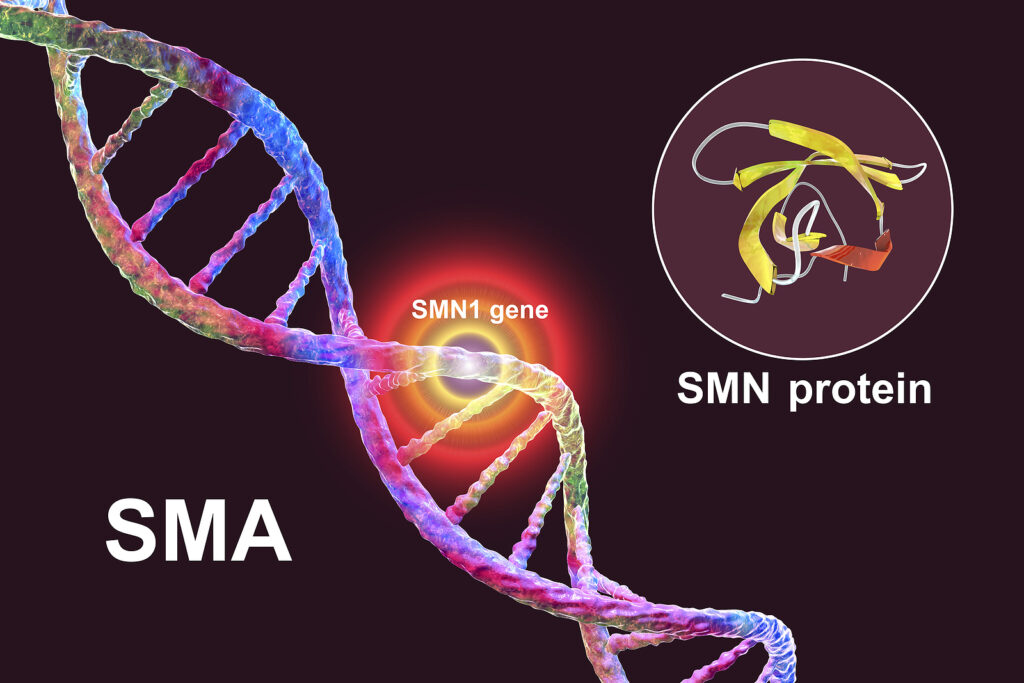By Lynda Williams, medwireNews Reporter
medwireNews: Children diagnosed with spinal muscular atrophy (SMA) through a newborn screening initiative have better functional outcomes than their peers diagnosed after the development of clinical symptoms, the SMARTCARE study findings show.
“Patients identified by newborn screening showed better motor development, less need for ventilator support and tube feeding, and less disease burden”, say Janbernd Kirschner (University of Freiburg, Germany) and co-workers in JAMA Pediatrics.
The team reviewed information on 234 children included in the SMARTCARE registry between 2018 and 2021, who had a confirmed diagnosis of SMA and up to three copies of SMN2 and were followed up for at least 18 months.
Overall, 18.8% of the children were diagnosed with SMA via a newborn screening pilot project conducted in two German federal states, while the remaining 81.2% were diagnosed based on clinical symptoms. The majority of both groups of children (95% and 97%, respectively) began treatment with an approved disease-modifying drug at an average age of 1.3 and 10.7 months, respectively, and were aged a mean 32.3 and 36.2 months at time of last follow-up.
Of note, 11 patients with two SMN2 copies detected by screening were symptomatic at the start of treatment, and two patients with three SMN2 copies did not begin treatment until the time of symptom onset at age 8 months due to parental preference. At the last follow-up, 22.6% of patients with two SMN2 copies and 76.9% of patients with three SMN2 copies were asymptomatic.
The team reports that children diagnosed with SMA by screening were more likely to meet major milestones than those diagnosed by clinical symptoms and they did so at an earlier age.
For example, 90.9% of screened infants were able to sit independently at a median age of 9.0 months versus 74.2% of clinically diagnosed infants at a median age of 14.0 months. Independent walking was achieved by 63.6% of screened infants at a median age of 17.0 months versus 14.7% of clinically diagnosed children at a median age of 23.5 months. Indeed, 40.9% of children diagnosed by screening were able to walk independently by age 18.0 months – the 99th percentile for normal development – compared with just 5.8% of those diagnosed by symptoms.
Moreover, none of the children diagnosed by screening lost a motor milestone during follow-up, whereas two children diagnosed by clinical symptoms lost the ability to sit and three lost the ability to walk before beginning treatment. Another patient lost the ability to sit independently at age 36 months during disease-modifying treatment.
At 18 months, the mean Children’s Hospital of Philadelphia Infant Test of Neuromuscular Disorders (CHOP INTEND) scores were 59.5 points in the newborn screening group and 47.7 points in the clinical symptom group, where a higher score indicates better function. These scores increased to 62.6 and 52.2 points at age 34 months, respectively.
“In both cohorts we observed a ceiling effect of CHOP INTEND scores”, the authors write. Among screened children, there was a significant correlation between presymptomatic status at diagnosis and change in CHOP INTEND score, and presymptomatic status and SMN2 copy number were also “closely associated”, they say.
Just 6.8% of screened children required intermittent ventilation. By contrast, 5.8% of children with clinical symptoms required permanent ventilation and 10.6% occasional use before beginning treatment, and a respective 2.6% and 16.8% did so after beginning treatment.
Exclusive and supplemental tube feeding were also less common, before and after treatment initiation, among children diagnosed by screening than via symptoms, the researchers add.
Finally, children diagnosed by screening were less likely to have adverse events than those diagnosed by symptoms (mean 0.3 vs 1.3 events per patient) and were less likely to require hospital stays for adverse events (mean 0.3 vs 1.0 events per patient).
“These results offer supporting evidence for the benefit of newborn screening for spinal muscular atrophy”, Kirschner et al state.
However, they caution that the “results demonstrate that not all patients benefited equally from newborn screening.”
The authors conclude: “While patients still asymptomatic at treatment initiation have a good chance of achieving independent ambulation, this is rather unlikely for those who already exhibited clear symptoms of SMA at treatment onset.
“These findings are important for prognostication and to counsel families with regard to treatment expectations.”
News stories are provided by medwireNews, which is an independent medical news service provided by Springer Healthcare Ltd. © 2024 Springer Healthcare Ltd, part of the Springer Nature Group
JAMA Pediatr 2024; doi:10.1001/jamapediatrics.2024.0492

